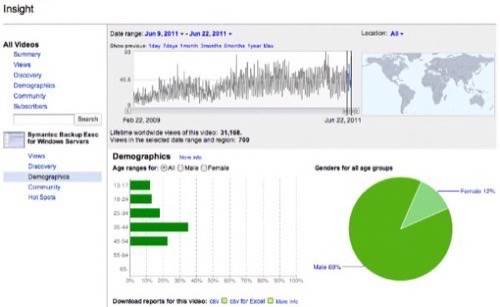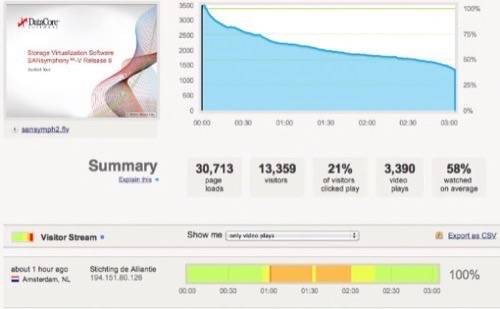As Web-based video becomes more prominent and more useful for businesses, the biggest issue is figuring out what resonates with your audience. You post a video and then what: how many people watch it all the way through? Should you have broken it up into shorter segments? Did you need additional details? Did people like the video and link back to it? Depending on the video site you use to share your content, you have a number of analytics and tracking tools at your disposal.

YouTube is the first place many of us – including myself – start, and certainly it
still has the lion’s share of the traffic. YouTube is great for beginners. It is easy to upload a video, share it across your Web site, and collect some very basic traffic statistics too. But you get what you pay for. Here is an example of what you can get from YouTube under their Insight tab:
You can see gross viewership by day, some demographics (age and sex), how they got to your video (via organic search or some other Web site) and so forth. This is a good starting point, and certainly better than nothing.

Viddler is another video sharing site, and they have their own analytics for their business account users, starting at $100/month. There are all sorts of tracking tools, and you can export some of this information to a CSV and then import into a spreadsheet for further reporting. My Viddler channel has not had much viewership but I don’t really know why, and have never upgraded to one of the paid business accounts.
The service that I use extensively for my own videos is from Wistia.com. Wistia has three differently priced plans, starting at $79 a month. You can try it out for 15 days for free. They combine several different things together: It has its own flash embedded player that allows you to easily adjust the size of your video window to match the dimensions of your Web pages. You can easily choose the thumbnail that you want displayed when the Web page is first viewed. Wistia isn’t alone in this particular space: Kaltura for example has a popular WordPress plug-in. But adding a Wistia embed tag to a custom WordPress self-hosted site is easier and no plug-ins are required to play your videos.
It is also a video hosting and sharing site. You have up to 20 GB of storage included in the basic account, with additional storage available at $2/GB/month. This 20 GB figure is just the size of the uploaded video files. Videos can be shared with your project team, where they can make comments (like Facebook) and downloaded, saving you the trouble of trying to send videos as email attachments. As video files can be larger than email attachment limits, this saves a lot of time and frustration.

Finally, Wistia has excellent analytics too, much more than is available from the other services. You have a list of all of the originating IP addresses and their reverse DNS lookups, so you have some sense of who watched your video. You also have a timeline of the video that shows you when someone stopped watching, or when they hit the rewind or fast forward buttons to get an idea of how they were or weren’t engaged in the video itself – that is shown by the color of the bar graph for each visitor. You can see how your viewership declined during the run of the video – with some of my videos, I lose more than half of the audience by the time the last frame is shown. The longer the video, the more the drop-off can be, which is why the average video is getting shorter and shorter.
No matter which service you use to post your videos, you need to study these analytics regularly. You have to spend some time with the analytics pages for each video you post, and return back to the page on a regular basis (such as once a week or a month) to see what is getting watched and what isn’t. This helps you figure out what your audience is interested in, what portions of your video aren’t engaging your audience, and how you can make your next video more of a hit.
Good luck with your own business videos, and feel free to share some of the tools that you use to keep track of your own viewers.










